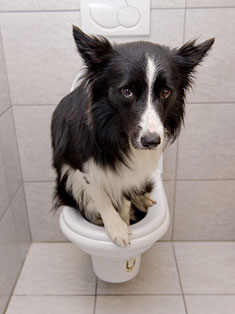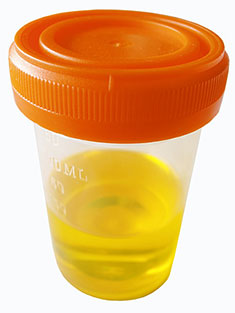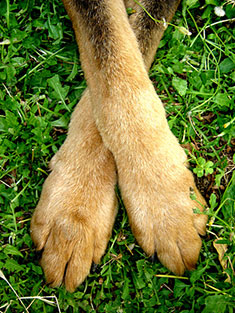Canine Urinary Tract Infections
Does your dog seem to be having trouble relieving his or her bladder? Urinary tract infections happen in about 2 - 3% of dogs at some point in their lifetimes. Learn how to recognize the signs of urinary tract infections and how to treat them before they spread.
Anatomy of the Urinary Tract
The canine urinary tract is divided into an upper and lower section. The upper section is composed of the kidneys and ureters, while the lower tract is made up of the bladder and urethra. The kidneys filter the blood, pulling out toxins and waste products. Water follows the microscopic products, creating a mixture we call urine. Urine passes from the kidney filtration system into the ureters, from where it is directed to the bladder.
The bladder expands as the amount of urine grows, then when the dog becomes uncomfortable with the amount of stretch in the bladder, he or she asks to go outside (in theory). Once outside, the dog relaxes the muscles that hold the urine inside the bladder, releasing it to the urethra, from where it is discharged from the body.
Infections are much more common in the lower tract, but they can easily spread upwards if left untreated. Female dogs, because of their shorter urethra, are at a higher risk of urinary tract infections than are male dogs.

Symptoms of Urinary Tract
The earliest sign you may notice if your dog has a urinary tract infection is that the dog whimpers or strains when trying to urinate. Infected urine often burns as it exits the body, causing your dog discomfort. In addition, your dog may feel the need to empty his or her bladder more often, probably because the bladder is being irritated by the infection. Your dog may pace back and forth, trying to avoid going to the bathroom because of the pain associated with it, but eventually he or she will have to go outside, probably quite a bit more frequently than usual, and often with greater urgency because he or she has put it off. This urgency can lead to potty accidents inside the home.
Your dog may also have a fever or seem to be more lazy than usual. If you press lightly on his tummy, you may hear a whimper or groan, indicating some tenderness.
Collecting a Urine Sample
If you notice these symptoms, it's time to get a diagnosis. To do so, your vet will want to take a urine sample, which is much easier to get at home than at the office, but you have to be quick. Follow your dog outside, carrying a large spoon and a Styrofoam cup. When your dog squats to relieve him- or herself, put the spoon under the stream of urine, then dump it into the cup. You may have to practice a few times before your dog accepts your being there, but luckily he will be urinating quite frequently so you'll have plenty of opportunities to collect your sample.
You may be able to see blood, pus, or crystals in the urine with your naked eye, but even if you don't there may be microscopic changes in the urine that your veterinarian can use to make his diagnosis. You should also take a moment (just a short one) to notice the smell of the urine. Infected urine often has a foul odor.

At the Vet
Your vet will likely want to make sure there are no obstructions in the urinary tract, because an obstruction can cause the same symptoms as an infection. Blockage could come from an enlarged prostate, kidney stones, or a tumor growing in or near the urinary tract. Your vet will likely feel the dog's abdomen to look for lumps or swelling. He will also perform a rectal exam to check the dog's urethra and to feel the prostate in male dogs.
A urinalysis will be performed on the sample you bring to the office. The urinalysis determines the pH of the urine, as well as how concentrated or dilute it is, and the amount of protein in the urine. The urine will also be examined under a microscope to look for crystals, blood cells, and bacteria. If you are unable to bring a urine sample with you, the vet may use a catheter to withdraw urine from the dog's bladder or may stick a needle directly through the abdominal wall into the bladder to aspirate the urine.
For example, if the urine contains a lot of white blood cells, it would be an indicator of infection because the body's immune system relies on white blood cells to fight infection. White blood cells typically live in the bloodstream and are not normally found in the urine unless an infection is present.
Protein in the urine can indicate that the bladder is inflamed or that the kidneys are allowing protein to be filtered from the blood, which is not normally the case.
Dilute urine can indicate that the dog is drinking excessively, a common indicator of a bladder infection. If the urine is very dilute, it can make it difficult to spot white blood cells and bacteria, meaning that the urinalysis will come back within normal limits, even though the dog is indeed sick.
A small amount of the urine will be used for a urine culture and sensitivity test. For this, the vet spreads a small amount of urine into a Petri dish and places the dish aside to allow the bacteria to grow over the course of a few days. In certain spots of the dish, antibiotics are also smeared. At the end of the growing period, the vet examines to Petri dish to see which antibiotics kept the bacteria from growing. The vet may also put a small amount of the bacteria on a slide to look at under the microscope to determine what type of bacteria is causing the infection.
Because a culture takes a number of days to grow, your vet will likely start your dog on an antibiotic that is effective against a wide range of bacteria at the initial visit. If the antibiotics are effective, no further medication is needed, but if the initial antibiotics don't work, the culture results will guide the vet in selecting another drug that is more effective against the specific bacteria causing the infection.

Causes of Canine Urinary Tract Infections
The entire urinary tract of a dog should be sterile or free from bacteria, although the end of the urethra nearest to the outside of the body often harbors a few bacteria. In most cases of urinary tract infection, bacteria enter the urinary tract through the urethra and travels upward.
The passage of urine through the urethra on a regular basis, along with the natural acidity or the urine is usually sufficient to keep the bacteria from growing uncontrollably and advancing up into the bladder. However, if the bacteria are especially aggressive, or if the urine pH changes, or if the dog doesn't urinate enough, the bacteria can overgrow the urethra and cause a clinical level of infection.
The higher up the bacteria travel, the more serious the infection is. With infection comes inflammation, which can cause irreversible damage to the lining of the urethra, bladder lining, and kidneys. Inflammation can cause your dog to hold his or her urine inside because it hurts to urinate as the urethra swells and the opening becomes smaller. In turn, the retained urine can begin to crystallize into stones which can block the urethra altogether or can damage the delicate filtering tubules in the kidneys.
Inflammation is the main cause of most of the symptoms of a urinary tract infection, and in fact, if your dog is on anti-inflammatories for another reason, such as for the pain of arthritis, you may miss the early signs of an infection. If your dog regularly takes anti-inflammatory medication, you should be especially vigilant in watching for urinary tract problems.
Treatment of Urinary Tract Infections
The gold standard of treatment for a urinary tract infection is antibiotics, most typically amoxicillin or fluroquinolones. Cipro is also sometimes used, but has not been approved for this use by the FDA. If the infection has been caught in its earliest stages, antibiotics will likely be prescribed for 14 days. Later, if the infection has traveled to the kidneys, treatment will be required for 30 days.
It is vital to take all of the antibiotics until they are gone, even if your dog begins to feel better after just a few days. Taking an antibiotic for fewer than the prescribed number of days allows a small number of bacteria to survive, and the infection will come back after treatment. When it does, the bacteria will be stronger and may become resistant to common antibiotics, making treatment much more expensive and less successful in the long run.
At the end of the treatment period, your vet will likely want to take another urine sample to make sure the infection has truly been cured and all bacteria eradicated from the dog's body. If not, an additional course of antibiotics may be required.
Prevention of Urinary Tract Infections
The most important step you can take to keep your dog from getting UTI's is to keep the urine flowing. Provide plenty of fresh water, and give your dog lots of opportunities to go outside or use potty pads inside. Walking is helpful in letting the dog empty his bladder completely.
Acidic juices such as orange, lime or cranberry, or apple cider vinegar, may be added to the dog's water to make the urine pH more acidic, which can help keep bacteria in check.
If your dog has an underlying endocrine disease such as Cushing's disease or diabetes, he or she will be at an increased risk of developing a urinary tract infection. In addition, dogs who have kidney failure, bladder cancer, or bladder stones are at a higher risk. These conditions can weaken the immune system and can give bacteria places to hide where antibiotics are unable to reach them.
Because the consequences of untreated urinary tract infections can be severe, it is vital that proper treatment be instituted as soon as symptoms are noticed.
Doggies Den: Latest Articles
 Homemade Thanksgiving Treats for Your Dog
Homemade Thanksgiving Treats for Your Dog
NUTRITION We all want to include our dogs in our holiday celebrations, but hopefully, you're aware that sharing table scraps with your dog isn't always the best idea.
 Keeping Your Dog Safe during the Summer Months
Keeping Your Dog Safe during the Summer Months
HEALTH Summer is coming on fast, so it’s time to plan how you will keep your dog safe and healthy through the lazy, carefree, warm days.
 Vaccination Time Again-Keeping Your Puppy Healthy
Vaccination Time Again-Keeping Your Puppy Healthy
DOG HEALTH So you have your new puppy picked out. There are quite a few shots, treatments and examinations that will keep the newest member of your family healthy.
 Canine Thanksgiving Feast
Canine Thanksgiving Feast
NUTRITION With the wide variety of food at Thanksgiving dinner, chances are you'll want to give your dog something special, too. If you're contemplating what to feed your dog for the holiday, here is a guide to a great Canine Thanksgiving Feast.
 Dog Walking Tips Every Owner Should Know
Dog Walking Tips Every Owner Should Know
DOG FUN Walking your dog is not only crucial to keeping him healthy and happy, it strengthens the bond between your canine friend and his caregiver. There are a lot of obstacles out there. Don’t forget these simple tips to keep your walk fun and safe in the outside world.
 The Benefits of Physiotherapy for your Dog
The Benefits of Physiotherapy for your Dog
HEALTH The same techniques that physiotherapists use to treat a variety of injuries and conditions in humans have been adapted to suit animals with great success. Family pets, show dogs, and working dogs can all benefit greatly from physiotherapy. Dogs whose activities involve a lot of agility are especially susceptible to the types of problems that physiotherapy can address.
 The Decision- Adding a Dog to Your Family
The Decision- Adding a Dog to Your Family
FIRST TIME OWNERSBringing a dog into your family is a decision where many people don’t realize it’s magnitude until after they have the dog. There are a number of things that you need to research before you decide to purchase a dog, and it starts right in your own home.
 Bringing Your Dog Into Your New Baby's Life
Bringing Your Dog Into Your New Baby's Life
HEALTH Many believe that a dog and a new baby cannot happily coexist, so therefore the dog has to go. This is not necessarily the case.  A new baby does not mean you have to abandon your dog.

Doggies Den:
Most Popular Articles

Dog Pregnancy Symptoms
HEALTHIf you suspect your dog might be pregnant, check out part one in this series on pregnant dogs, where we cover pregnant dog symptoms.

Dog Birth
HEALTHIn the third article of our dog pregnancy series, we look at the wonderful, but messy, process of bringing newborn puppies into the world.

Indoor Dog Potties
DOG PRODUCTSIt's been a long day at work. You were so busy, you didn't even take time to eat a sandwich, let alone run home to let your dog out. You're on your way home, knowing the poor dog is crossing his or her legs by now, when your car breaks down, delaying you even further. Can't somebody make this easier?

Your Dog’s Digestive System
PHYSIOLOGYEver wonder why your dog eats so fast? Or why he eats gross things? Or why he gets sick to his stomach? Or why his waste stinks so bad? Some of these things are normal, some are not.

Canine Respiratory System
BREATHINGThe basic function of your dog's respiratory system is to bring oxygen in to and remove carbon dioxide from the body. Knowing the symptoms of respiratory diseases can help you help your stay healthy.

Shelter Dog Adoption Tips for Success
ADOPTION Are you intimidated by the prospect of "rescuing" a dog from a shelter? One reason that you may be wary of adopting a dog from a shelter is not knowing how to choose. Adopting a dog from a shelter can be a rewarding process, if you're prepared to do a reasonable amount of research.

Canine Urinary Tract Infections
SYMPTOMS AND TREATMENTDoes your dog seem to be having trouble relieving his or her bladder? Learn how to recognize the signs of urinary tract infections and how to treat them before they spread.

What to do for Dog Diarrhea
SYMPTOMS AND REMEDIESIf you have dogs in your house for any length of time, you have likely experienced at least one bout of dog diarrhea. Beyond the pain in the tuckus involved in cleaning up the mess, you should know what causes diarrhea, and when it's important to see the vet.

What to do for a Dog Bite
DOG BEHAVIOR Getting bitten by a dog can be scary, and you may be tempted to run around in circles for a while, trying to figure out what to do. Here's our guide to help you manage the situation.

Top Ten Tips for Living with a Senior Dog
DOG HEALTH Bringing home a new puppy is so exciting, but it doesn’t take all that long for your exuberant puppy to grow into a senior dog who may have special needs. Here are the doggies.com top ten tips for taking care of your companion who has been with you through so much.
